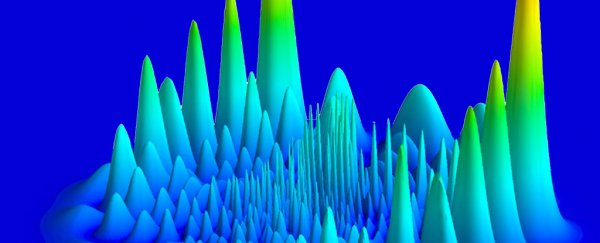For the first time, physicists have observed a strange molecule called the butterfly Rydberg molecule - a weak pairing of highly excitable atoms that was first predicted back in 2002.
The find not only confirms a 14-year-old prediction - it also confirms the existence of a whole new type of atomic bond.
Rydberg molecules form when an electron is kicked far from an atom's nucleus, making them super electronically excited.
On their own, they're common enough. But back in 2002, a team of researchers from Purdue University in Indiana predicted that a Rydberg molecule could attract and bind to another atom - something that was thought impossible according to our understanding of how atoms bind at the time.
They called that hypothetical molecule combination the butterfly Rydberg molecule, because of the butterfly-like distribution of the orbiting electrons.
And now, 14 years later, the same team has finally observed a butterfly Rydberg molecule in the lab, and in the process, has discovered a whole new type of weak atomic bond.
"This new binding mechanism, in which an electron can grab and trap an atom, is really new from the point of view of chemistry," explained lead researcher Chris Greene. "It's a whole new way an atom can be bound by another atom."
Rydberg molecules are unique because they can have electrons that are between 100-1,000 times further away from the nucleus than normal.
The team was able to create them for this experiment by cooling Rubidium gas to a temperature of 100 nano-Kelvin - one ten-millionth of a degree above absolute zero - then exciting the atoms into a Rydberg state using lasers.
The team kept these Rydberg molecules under observation to see if they could indeed attract another atom. They were looking for any changes in the frequency of light the molecules could absorb, which would be a sign that an energy binding had occurred.
Eventually, they discovered that the distant electrons could indeed help attract and bind with other atoms, just as they had predicted in 2002.
"This [distant] electron is like a sheepdog," said Greene. "Every time it whizzes past another atom, this Rydberg atom adds a little attraction and nudges it toward one spot until it captures and binds the two atoms together."
"It's a really clear demonstration that this class of molecules exist," he added.
These special butterfly Rydberg molecules are substantially larger than normal molecules due to their distantly orbiting electrons, and now that we know they exist, they could be used in the development of molecular-scale electronics and machines because they require less energy to move.
"The main excitement about this work in the atomic and molecular physics community has related to the fact that these huge molecules should exist and be observable, and that their electron density should exhibit amazingly rich, quantum mechanical peaks and valleys," Greene told The Telegraph's Roger Highfield in 2012.
We're looking forward to seeing what happens with them now.
The team's findings have been published in Nature Communications.
